2016 is the Year of the English Garden. It commemorates the 300th anniversary of the birth of England’s most celebrated landscape designer, Lancelot “Capability” Brown. The 18th-century visionary was responsible for creating more than 170 English gardens, including the rolling parklands at grand stately homes including Alnwick Castle in Northumberland, a key location in the Harry Potter films; Longleat in Wiltshire, now a safari park; and Althorp in Northamptonshire, where Princess Diana grew up. Here, you can enjoy a peek at three noteworthy English gardens, each designed in a different century but all with a link to the great man.
First, in a look at some of Brown’s finest landscapes, an expert reveals how to translate some classic Brownian tricks into tips for a small modern garden.
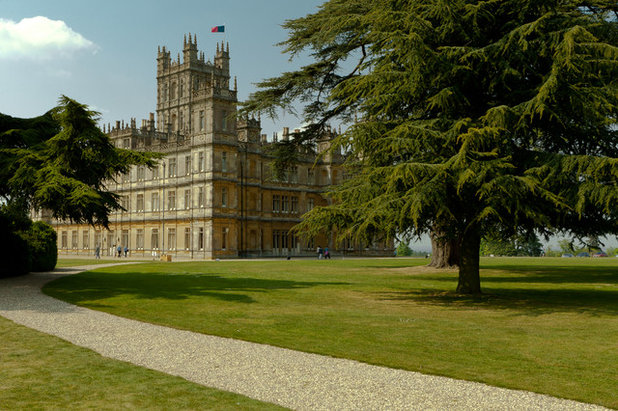
If you’ve ever watched
Downton Abbey, you may recognize this view of Highclere Castle, where much of the hugely successful television period drama was filmed.
Lancelot Brown was commissioned to enhance the gardens at Highclere in 1771. By then, he was already renowned for his trademark approach to landscaping, which influenced the English landscape movement — a deliberate move away from the previously fashionable formal Italian style that had shaped gardens across Europe, including, notably, the famous grounds at the Château de Versailles, outside Paris.
Brown started out as an apprentice of the head gardener at Kirkharle in Northumberland, close to where he was born. A few jobs later, he landed at Stowe in Buckinghamshire and worked under landscape architect William Kent, who became his mentor. Brown’s reputation soon exceeded that of Kent, however, and the high-profile commissions began to roll in.
Brown’s style has been distilled into one word: “Capability,” his nickname. He got the moniker because his design philosophy famously focused on responding to a site’s capabilities as determined by nature, rather than by imposing abstract demands or concepts on it. Many described his skill as making the landscape even more beautiful.
Across Highclere’s 1,000 acres, Brown extended lakes, built in hills and smoothed out existing bumps. One of the designer’s tricks was to create gardens full of incredible views. Here, deciduous trees and cedars were strategically planted to draw the eye toward dramatic vistas.
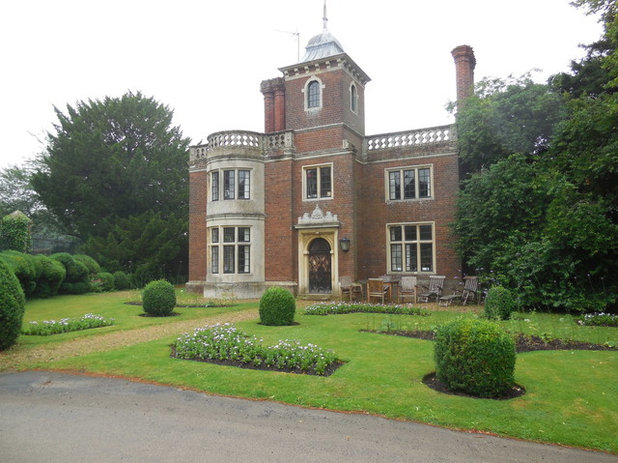
Cambridge Lodge, pictured, sits on the grounds of Audley End in Essex. Capability Brown modernized the landscape in 1762, updating a previously formal layout.
The River Cam runs through the site, but originally in the form of canals. A key change Brown made — illustrating one of his trademarks — was his reworking of the canals into a winding lake, which he dotted with naturalistic groupings of trees.
Ideas for Small GardensWith lots of us now keen to encourage more wildlife into our gardens, there’s a growing trend for more naturalistic designs, making Brown’s ideas seem more relevant than ever. And they can be put to work even in a small garden, says John Phibbs, principal of Debois Landscape Survey Group, a consultancy specializing in the management of historic landscapes; founder of the Brown tercentenary celebrations; and editor of Capability Brown resource The Brown Advisor.
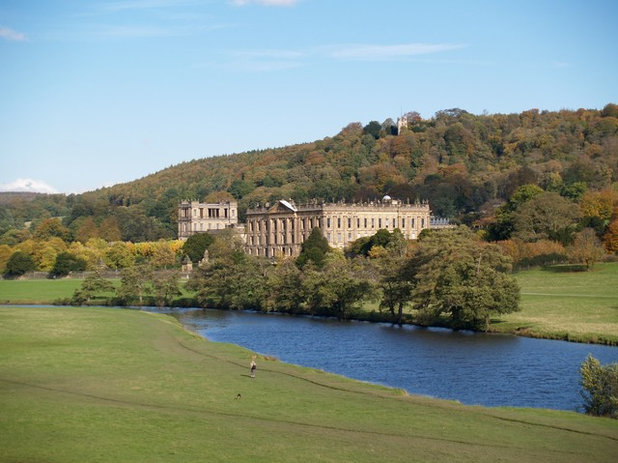 1. Add Water
1. Add WaterAt Chatsworth House, which was used as the location for Pemberley in the 2005 film of Jane Austen’s novel
Pride and Prejudice, Capability Brown widened the River Derwent, which runs through the estate. While this level of landscaping isn’t an option for most of us, Phibbs suggests a simple way to channel the spirit of the idea.
“Lakes are important in his designs,” Phibbs says. “If you have a small garden and want to be Brownian, avoid a pool and go for something that is more like a stream — something which provides a sense of freedom and of breaking boundaries, perhaps running to a river and on to the sea.”
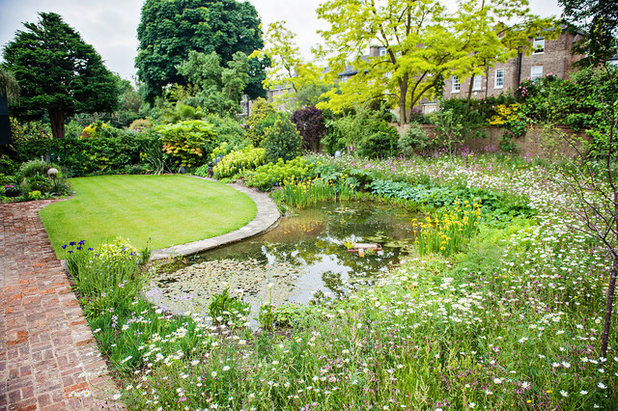
The Garden Builders
Still struggling to picture this in your own postage-stamp patch? “Make your pond long and thin, rather than circular,” Phibbs says. It’s an idea used in this decent-size London garden, which could easily be scaled down further still. “This can also provide a good boundary between your veg plot and flower garden,” he says.
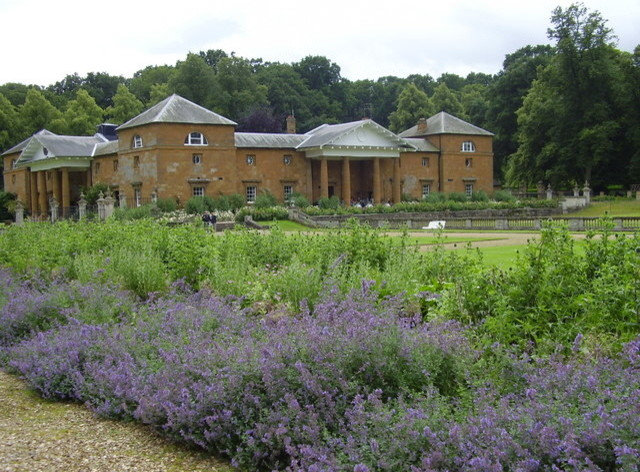 2. Add — but Conceal — a Path
2. Add — but Conceal — a PathAt the previously mentioned Althorp, pictured here, you can see another classic Brownian trick that’s also easy to adapt in a smaller space. You can hide a garden path behind shrubbery so that it’s invisible from the house, giving the impression — as you gaze out the window — of a rolling and uninterrupted pastoral scene, even if you’re in the middle of a city. In the next photo, you can see this idea translated in a modern garden in west London.
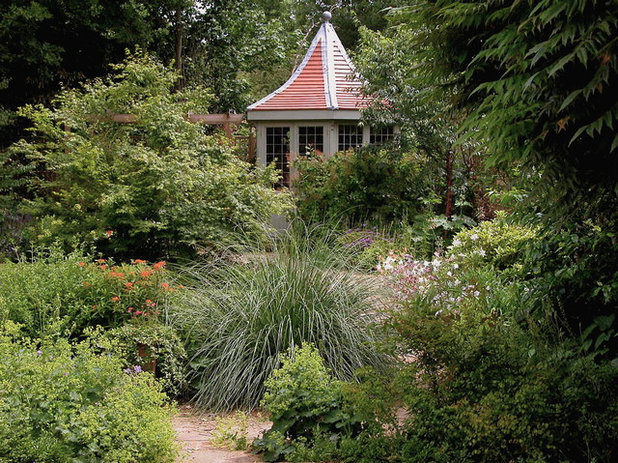
Garden Arts
If this garden walkway were even more winding, it could be entirely concealed, creating even more of a Brownian effect.
Pathways through a garden were an important detail to Brown, Phibbs says. In the grand gardens of stately homes, there would be two distinct pathways built to lead you through the garden’s best vistas: a gravel route for the winter, winding around points of interest like a bench or a decorative feature, and a grass path for summer use, set further into the open space of the garden.
To disguise hardscaped paths Brown-style, Phibbs suggests positioning them close to fences, and concealing them with shrubs and bushes.
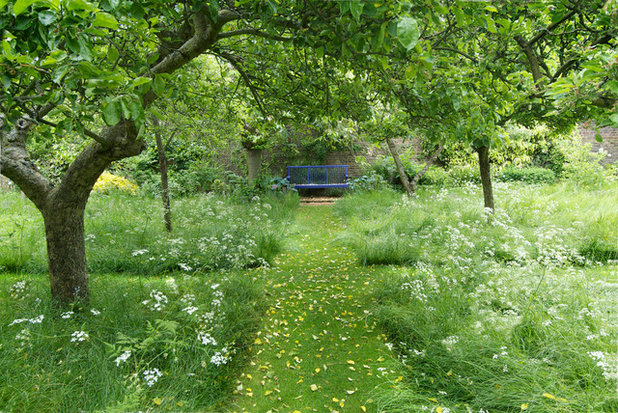
Todd Haiman Landscape Design
For hiding a smooth mown path, Phibbs says Brown would raise the turf around the path a few inches, making the path effectively vanish when viewed from the side.
For the same effect, “you could also grow longer grasses around it,” he says. The smooth-mown path would be concealed Brown-style by being a little lower than the surrounding grass. In the photo above, imagine looking across the paths from a distance.
Phibbs says: “You just get a sense of green — it gives a garden a softer, greener and more harmonious sense — a world away from modernist gardens, a much gentler approach.”
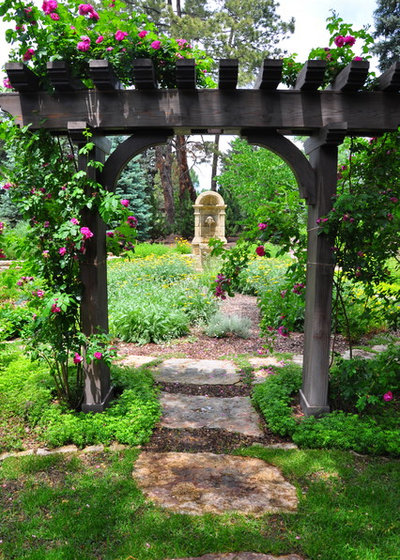
Designscapes Colorado Inc.
3. Create a Vista“It’s very common in a long town garden that you might have a ‘pinch point’ — a pergola or an arbor or piece of trellis work,” Phibbs says. He relates this modern-day idea to Brown’s skill for using garden structures or buildings to create vistas. “You walk through it and, at the far end, you see — for example — a little white bench.” In this naturalistic garden, there’s a stone decorative feature as a focal point.
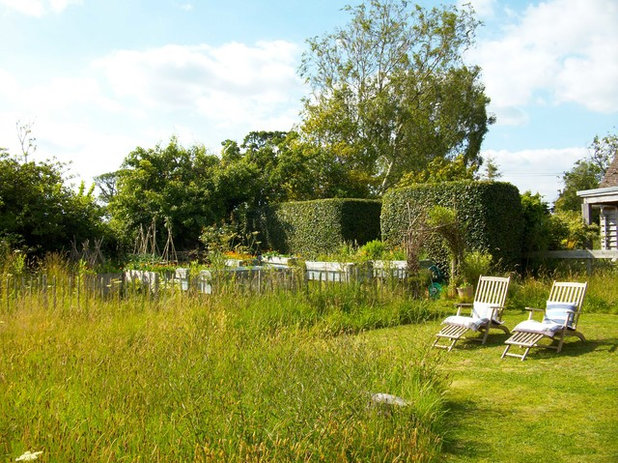
Couture Gardens
4. Go Wild — in the Right PlacesEarly in Brown’s career, he developed the idea of the graduated design, Phibbs says. It’s simple to achieve. “This is where you mow the part of the garden closest to your house and then leave the rest to grow wild, perhaps with ponds and the sense of a small nature reserve. That’s really what Brown was doing.”
5. Work With NatureA little later in Brown’s career, the landscaper began to look around at the estates and spaces he was designing and tried to follow what’s called
genius loci, a Latin phrase meaning “the spirit of the place.” Phibbs explains: “In other words, working with what nature has already provided, but just, you know, making it even better. As any horticulturist would recommend, you should put plants where they like to live — for example, acid-loving plants in boggy ground.”
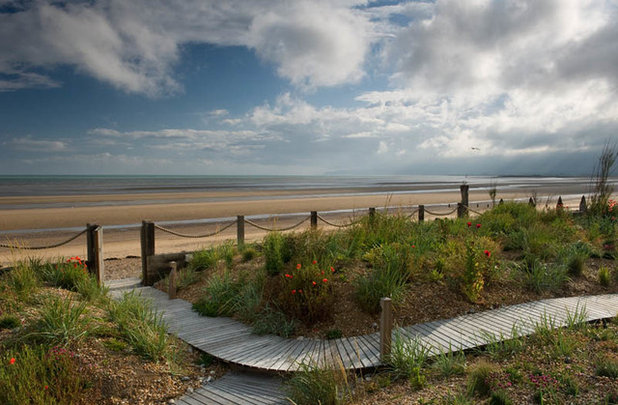
Jo Thompson Landscape & Garden Design
6. Lose the Fence“In his last phase of work,” Phibbs says, “Brown starts to recognize England itself as a beautiful garden, incorporating whole villages into his landscapes. And so the line between the designed landscape and the countryside beyond dissolves completely — it’s almost a spiritual thing. Althorp, Belvoir and Milton Abbey are great examples of this.” And when you have something this beautiful to see beyond your garden boundary, why wouldn’t you incorporate it?
And in a regular, perhaps urban, garden without quite these views at hand? Phibbs chuckles and says: “This is where you and your neighbors rip out all your fences. And then you’ve achieved enlightenment!”
Next, to further celebrate the Year of the English Garden, we look at three very different English gardens, each with a link to Capability Brown.
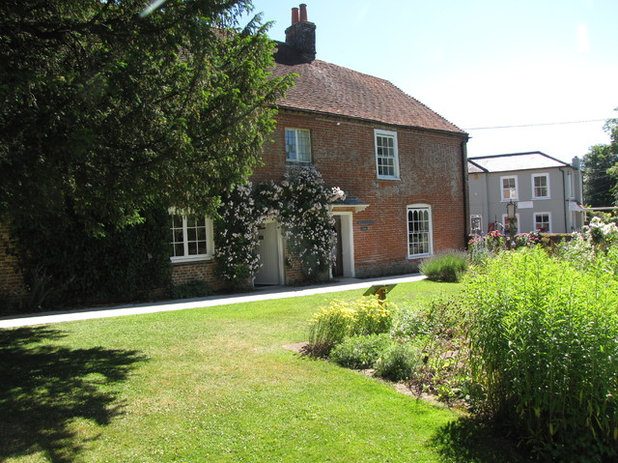 Capability Brown’s Legacy
Capability Brown’s Legacy
1. The Historic GardenThe home garden of writer Jane Austen in Chawton, Hampshire, pictured here and in the next three photos, was very much in the traditional English country cottage style — quite different from those designed by Capability Brown.
But in 1811, two years before her novel
Pride and Prejudice was published, Austin visited Chatsworth, whose gardens Brown designed. Many people, including Chatsworth’s owners, believe that she used the residence as a model for the home of Mr. Darcy in
Pride and Prejudice. As mentioned earlier, the estate appeared in the 2005 film adaptation
.In the novel’s description of Elizabeth Bennet’s arrival for the first time at Pemberley, Austen describes a classic Brown-esque winding drive — an approach designed to tease, and then reveal, a great vista.
“They gradually ascended for half a mile, and then found themselves at the top of a considerable eminence, where the wood ceased, and the eye was instantly caught by Pemberley House, situated on the opposite side of a valley,” Austen writes in the book. “It was a large, handsome, stone building, standing well on rising ground, and backed by a ridge of high woody hills.”
A reference to Brown’s trademark tricks continues in the same passage: “[I]n front a stream of some natural importance was swelled into greater, but without any artificial appearance. Elizabeth was delighted. She had never seen a place for which nature had done more, or where natural beauty had been so little counteracted by an awkward taste.”
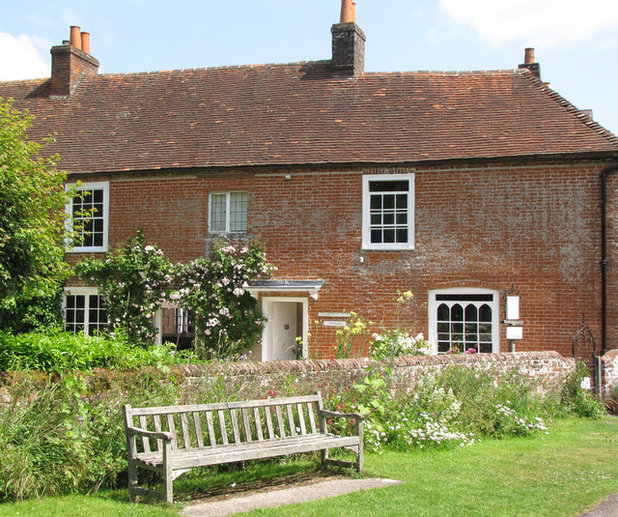
Austen’s personal garden is now part of Jane Austen’s House Museum and is open to the public. It’s looked after by gardener Celia Simpson, who strives to choose only plants and shrubs that would have been available to the Austens when they lived there. These include plants used in the dyeing process, such as tickseed, which produces a yellow, green or rust color, and madder, which produces a red hue.
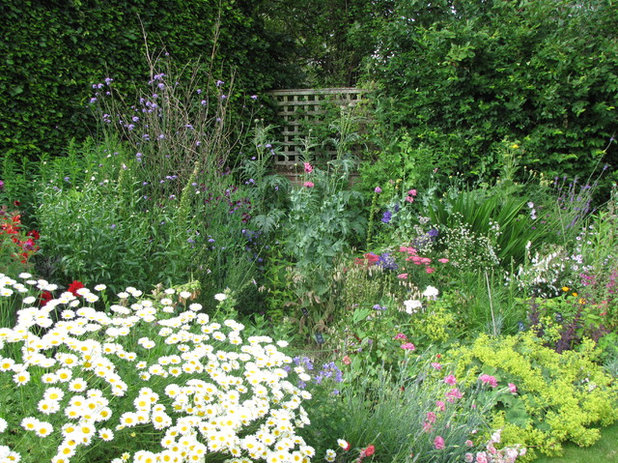
We know some of the flowers that grew in the garden while Austen lived at the house, as she mentioned them in a letter to her sister, Cassandra: “[T]he whole of the shrubbery border will soon be very gay with pinks and sweet-williams, in addition to the columbines already in bloom. The syringas, too, are coming out.”
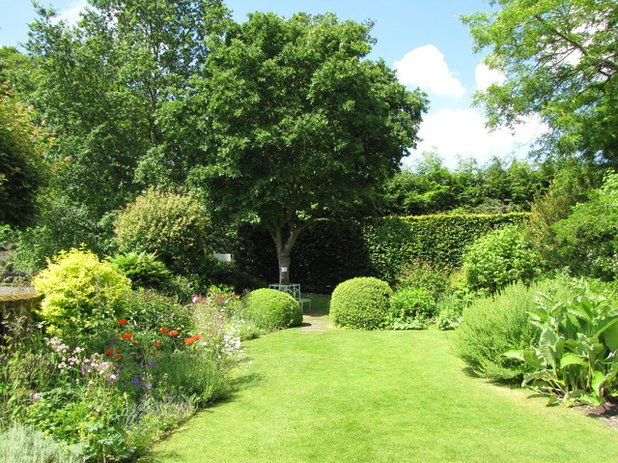
In his memoir of his literary aunt, James Edward Austen-Leigh recalled the garden as having “a pleasant irregular mixture of hedgerow, and gravel walk, and orchard, and long grass for mowing.”
Here, two herbaceous borders lead the eye toward a tree-shaded seating area — a Capability Brown “vista” of sorts.
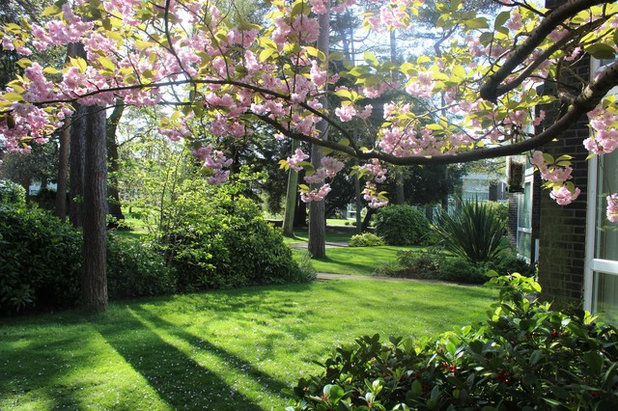 2. The Midcentury Communal Garden
2. The Midcentury Communal GardenWhen you think of midcentury modern interior design, you might imagine that a garden of that era would also be sleek and minimalist. Not so in the case of the communal gardens at Templemere in Weybridge, Surrey.
The 1963 estate, pictured here and in the next three photos, has 65 houses. The development was one of 73 conceived by noted English architect Eric Lyons and built by Span Developments mostly in southeast England. The renowned projects were intended to be an alternative to the suburban identikit new-builds of the day.
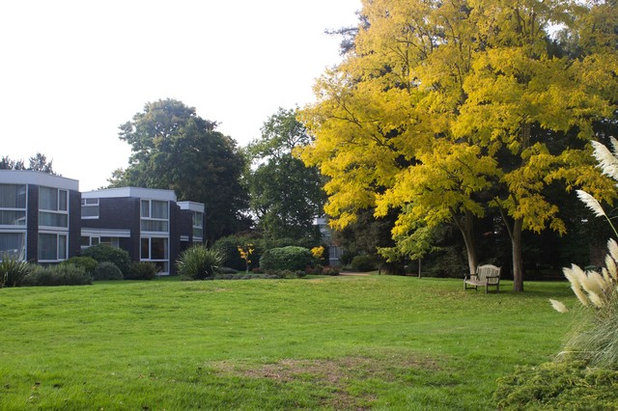
Their idea was to bring the outside in through the houses’ trademark large windows while blending them with their surroundings. Each house typically had its own small garden, but the focus was always on the beautifully landscaped communal gardens. These have a lot in common with the designs of Capability Brown, according to resident Matthew Baxter, part of a team at Templemere responsible for maintaining the grounds, and the son of Warner Baxter, Lyons’ architectural partner.
Templemere has a particularly strong link to Brown, since it was built on the foundations of a 12-acre site designed in the 18th century by William Kent, Brown’s mentor. And the landscaping is respectful to its history: “The designers were about working with what was already there,” Matthew Baxter says. “This makes a garden more expensive to create, and more complex, but it makes it more exciting.
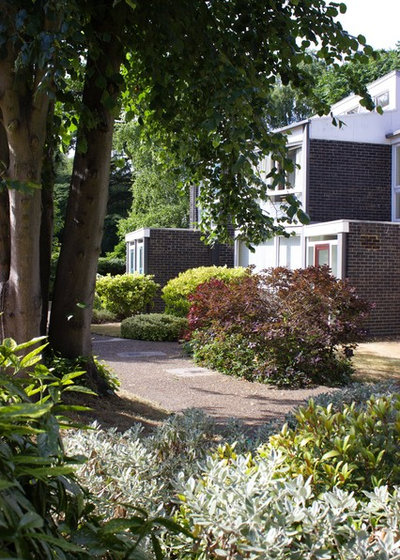
“One of the things they borrowed from those classical Capability landscapes,” says Baxter of the design team, “is that you
have these progressive vistas. It’s very clever and very classic and something that Kent was good at.
“When you walk around, as well as when you drive in, suddenly at each turn there are big, different views. That is design skill — you put something to block the view until the moment is right to reveal it, making the sight of it all the better for being kept hidden until that perfect point,” he says.
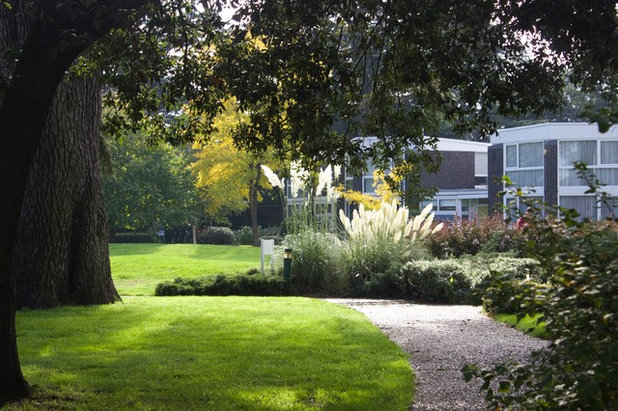
“They also buried the paths, insetting them into the green so that they’re invisible when you look from a distance,” Baxer says. You can see this in effect here, as the path appears to vanish as it curves. You can also see how shrubbery has been planted to further disguise the path from the houses.
The gardens at Templemere — which include woodland and a lake — have an approved plants list, Baxter says, with the aim of keeping the space as close to the original planting plans as possible. Permitted shrubs include pampas grass, visible clearly in this shot, along with
Phormium,
Amelanchier,
Hydrangea petiolaris, laurel and rhododendron. Sequoia, cedar, sycamore and silver birch trees were original to the site, with approved additions including mountain ash and holly. Ivy, lavender and box are among the approved plants and ground covers. “There are no flowers,” Baxter says. “This is a key part of the design [aesthetic]. I think the designers were thinking about plants as a sculptural thing rather than a series of species, about using them to reveal surprises and to make shapes.”
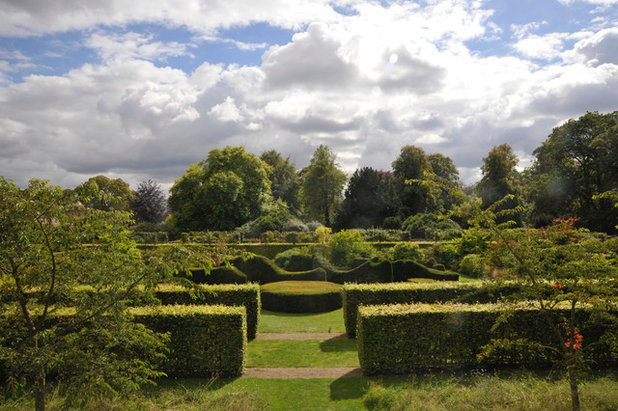 3. The Contemporary Garden
3. The Contemporary GardenThe dramatically contemporary walled garden at Scampston Hall, a stately Regency home in North Yorkshire, sits amid 80 acres of rolling parkland designed by Brown. The walled garden, thought to originally have been constructed by Brown when he redesigned the parkland around it in 1782, was created in 1999 by renowned Dutch plantsman Piet Oudolf, and is pictured here and in the next four photos. The Dutchman also designed New York’s High Line, the County Cork Garden in Ireland and Sweden’s municipal park at Enköping, and he is known as a pioneer of the New Perennial Movement.
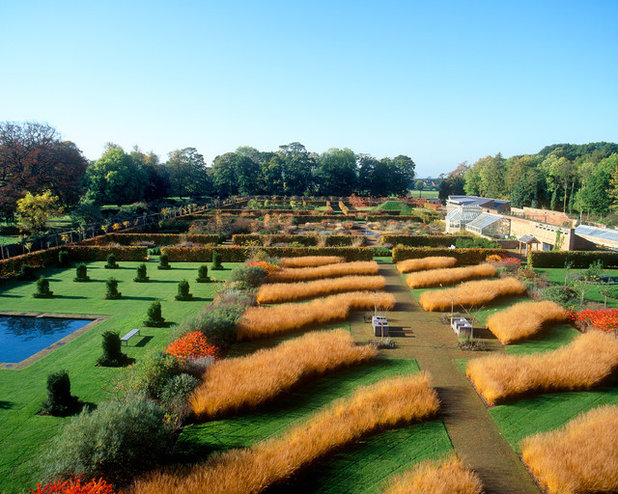
“The key features of this movement,” says garden designer Claudia de Yong, “is the use of herbaceous perennials and grasses en masse, and the willingness to embrace those plants throughout the changing seasons.” Scampston includes great drifts of grasses, perennial meadow plantings and herbaceous borders, all seen in this image.
“Grasses add movement where hedging can be static and, with the changing of the seasons, the colors of the grasses will add more interest as they continue to turn into deep oranges, fiery reds and soft sandy colors,” de Yong says. “The mix of texture with grasses against the dark green of the hedging is very effective too and resembles fields of wheat or hay.”

As you can see, this style of gardening works beautifully in large spaces. But even in small gardens, “adding prairie-style planting extends the flowering seasons in your garden, and, by using grasses, you can also add structure and movement,” de Yong says.
“Formal hedges add structure to a garden and, if they are evergreen, will help the overall look in the winter months,” de Yong says. “Soft grasses, which you can leave over winter, can also look great with frosts catching the tips. The idea is to combine a bit of structure with the flowing soft movement so you have the feeling, when sitting down, that you are amongst the plants. Grasses can be planted in beds to knit together large planting areas, and will carry the structure through to winter if left and not cut down,” she says.
Browse profiles of ornamental grasses
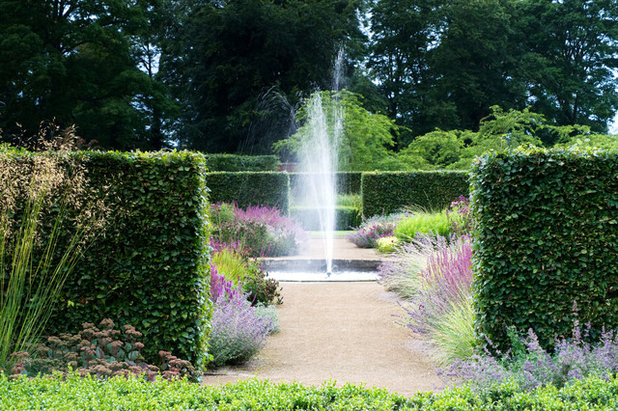
“A central small or large water feature, which could simply be a large pot with bubbling water, adds another dimension to the planting areas and leads the eye to the middle of the space,” de Yong says. “Even a birdbath on a pedestal placed centrally can be effective. A small raised brick pond will also look good, and you can plant around any central water feature with grasses to add movement.”
Bring in the Birds With a Homemade Bubble Rock

Here’s a view across grasses and plants, including
Phlomis russeliana, geranium,
Salvia and
Echinacea pallida. “To achieve this look, you must plant in large numbers,” de Yong says. “Don’t be afraid of planting in 15 or more of one variety — and make sure the colors fade gradually into the distance, as bright colors will stop the eye.”
Tell us: Which of these ideas would you try out in your garden? Let us know in the Comments below.





